 |
 |
| |
-Bottom Cleaning |
| |
-Zinc Replacement |
| |
-All props works |
| |
-Wax/Compound. We are the BEST!! |
| |
-Docks and piling repairs - cleaning |
| |
-Other services are:
 • Top Wash service • Top Wash service |
| |
 • Canvas removal or installation (costume made) • Canvas removal or installation (costume made) |
| |
 • Inspections • Inspections |
| |
|
| |
|
| |
|
| |
|
| |

We are associated with one of the top propeller services located in South Florida.
Prop Replacements
Propellers 3,4,5,6,7,8 Blade to any diameter.
Removed and Replaced and repaired.
A Propeller chance consists of:
1 - Diver to remove and replace propellers with your spares that are on the dock at the time of service.
2- Diver to remove, take to propeller shop and deliver back and install.
Call us (786)200-7154 or email us mailto:thelordoftheboats@gmail.com
to let us know what we can do for your prop and running gear.
More info... |
| Click on image to enlarge |
|
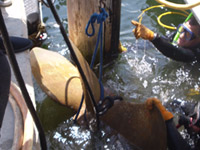 |
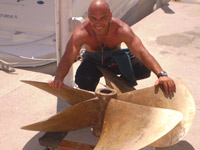 |
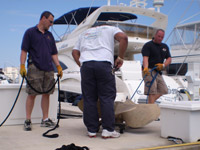 |
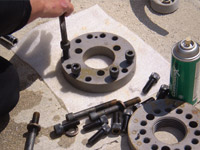 |
|
|
|
|
|
| |
|
| |
|
| |
|
| |

In clean air untreated teak weathers to an attractive ash gray, but where most boats live, the assault of modern-day air pollutants quickly turns bare teak nearly black. Scrubbing tends to leave behind an unattractive mottled look, neither golden nor gray. Most boat owners eventually find themselves unhappy with either look and decide that some treatment is essential.
If we want the natural beauty of the wood to show, we must apply a clear coating.
The choices are oil, sealer, or varnish.
Cleaning
Before teak can be given any coating, it must be completely clean.
Oil
Oiling teak on boats is a time-honored tradition. Oil intensifies the colors and grain patterns of wood and gives the wood a rich, warm appearance, and it restores some of the teak's natural oils and resins. Oiling requires multiple coats. The benefit of oiling exterior teak is transitory.
Sealers
Another approach to achieving a natural look is the application of a sealer. Durability and ease of application have made some sealers very popular with boatowners. Sealers don't feed the wood but, as the name suggests, they seal out moisture and dirt, and seal in natural oils and resins. Maintain sealed wood by washing it and applying a fresh coat of sealer every two to three months.
Varnish
Aside from its much-admired appearance, varnish offers genuine protection for the wood. Wood coated with varnish will not dry out and split, will not absorb moisture and rot, is unaffected by dirt and pollution, and will be untouched, thus unstained, by oily or greasy spills.
More info...
|
| Click on image to enlarge |
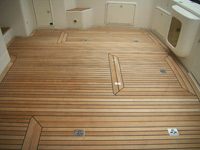 |
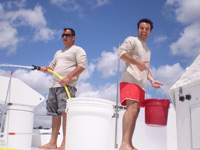 |
|
|
|
| |
|
| |

Zincs and Electrolysis
Whenever different metals are placed in a conductive liquid you create a battery. If you connect these pieces of metal together, current will flow. The current will be removing metal from one of the metal pieces = "electrolysis". If this piece is the zinc in your flashlight battery that is good, but if one of the pieces is your propeller it is bad.
The zincs you use on a boat are called "Sacrificial Anodes". Zinc is used because it has a higher voltage in the water so the current will be more inclined to flow from it than from your propeller. To complete the electrical circuit, the zincs must be connected to the items they are intended to protect. Usually this is no problem because the zinc is bolted right to the shaft or underwater housing. Non metal boats will usually have a copper bonding wire inside that connects all the underwater metal items together so they all share the protection from zinc anodes. Since engines use the metal frame as the negative battery connection and the engine is connected to the prop shaft, the engine and the negative side of your 12 volt system are also part of this bonding connection. This bonding wire is usually connected somewhere to the rigging. This is not for electrolysis protection but for some protection from lightning strikes to conduct it into the water through the items connected together.
It would be hard to overstate the importance of maintaining the zinc anodes on your boat. When a zinc is gone, the metal component it was installed to protect begins to dissolve-guaranteed.
How much zinc
The amount of protection a zinc anode provides depends on its surface area. The zinc surface area needed varies with the kind of metal being protected and with the chemical make-up of the water, but you can use 1% of the surface area of the protected metal as a starting point. Check the protected metal frequently. If it shows signs of corrosion despite the zinc, you need more surface area.
Zincs should be replaced when 50 % of the anode has been lost to corrosion.
Normally check all zincs at least every 4 to 6 months and replace all that are half depleted. Here are some replacement guidelines.
Electrical contact is essential
For a zinc anode to provide any protection, it must be in electrical contact with the metal being protected or by connecting the two with a wire. The conductivity of the water is not adequate .A hanging anode can provide protection if it is connected by a wire to the metal being protected.
No paint
Zinc anodes cannot perform their function unless they are exposed. Putting paint on zinc smothers it, rendering it useless. Never coat zinc anodes with bottom paint, or anything else.
Props and rudders
Propellers are normally protected by a zinc collar fashioned in two pieces and bolted together around the shaft forward of the propeller. It is essential to make sure the shaft is clean and bright before clamping the collar to it. Corrosion protection for outboard and outdrive propellers is typically provided by a bolt-in-place zinc ring or a zinc prop nut.
More info...
|
| Click on image to enlarge |
 |
 |
 |
|
|
|
| |
|
| |

Docks products – Sale & installation
-Dockside recovery of overboard items
Please use the email link above or call us to receive a free estimate. Please be sure to include the size or your boat and the last time it was cleaned.
More info...
|
| Click on image to enlarge |
|
 |
|
|
|
|
| |
|
| |

- Dockside recovery of overboard items
- Top Wash service
- Canvas removal or installation (costume made)
- Inspections
More info...
|
| Click on image to enlarge |
|
 |
 |
 |
 |
|
|
|
|
|